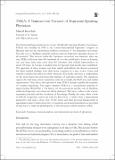Files in this item
TEKA : a transnational network of Esperanto-speaking physicians
Item metadata
| dc.contributor.author | Koschek, Marcel | |
| dc.date.accessioned | 2021-11-25T15:30:05Z | |
| dc.date.available | 2021-11-25T15:30:05Z | |
| dc.date.issued | 2021-06-01 | |
| dc.identifier | 276252726 | |
| dc.identifier | eb038ddd-c667-44fe-9708-88ccdbbe3d43 | |
| dc.identifier.citation | Koschek , M 2021 , ' TEKA : a transnational network of Esperanto-speaking physicians ' , The Hungarian Historical Review , vol. 10 , no. 2 , pp. 243-266 . https://doi.org/10.38145/2021.2.243 | en |
| dc.identifier.issn | 2063-8647 | |
| dc.identifier.uri | https://hdl.handle.net/10023/24400 | |
| dc.description.abstract | The Tutmonda Esperanta Kuracista Asocio (Worldwide Esperanto Medical Association, TEKA) was founded in 1908 at the Fourth International Esperanto Congress in Dresden and was the international medical association of the Esperanto movement. The aim was to “facilitate practical relations between Esperanto-speaking doctors of all countries.” The interest within the Esperanto movement was immense: after one year, TEKA had more than 400 members all over the world with a focus on Europe; one year later, there were more than 600 members with official representatives in about 100 cities. In Europe, a medical press in Esperanto had already been established. The approach of these journals was both simple and brilliant: the doctors presented the latest medical findings from their home countries in a peer review system and critically examined the articles in their vernacular. This made each issue a compendium of the most important and pioneering findings of national research. The numerous experts also had many other connections with, for example, the Red Cross and similar organizations. Thus, after a short period of time, TEKA brought together the expertise of countless physicians. This paper examines TEKA as a transnational network of experts before World War I. The history of the association and the role of Medicine within the Esperanto movement are briefly discussed. The focus is then on the various association journals and the circulation of knowledge. Finally, the essay offers a look at TEKA’s cooperative endeavors with the Red Cross. It works from a transnational perspective and takes a close view of the actors and their personal backgrounds at appropriate points. Furthermore, lists of members and journal subscribers are provided in map form to make the global spread of the movement within medicine visible. | |
| dc.format.extent | 539433 | |
| dc.language.iso | eng | |
| dc.relation.ispartof | The Hungarian Historical Review | en |
| dc.subject | Internationalism | en |
| dc.subject | Network of physicians | en |
| dc.subject | Esperanto | en |
| dc.subject | Transnationalism | en |
| dc.subject | PM Hyperborean, Indian, and Artificial languages | en |
| dc.subject | R Medicine | en |
| dc.subject | 3rd-DAS | en |
| dc.subject | NIS | en |
| dc.subject.lcc | PM | en |
| dc.subject.lcc | R | en |
| dc.title | TEKA : a transnational network of Esperanto-speaking physicians | en |
| dc.type | Journal article | en |
| dc.contributor.institution | University of St Andrews. School of History | en |
| dc.identifier.doi | 10.38145/2021.2.243 | |
| dc.description.status | Peer reviewed | en |
This item appears in the following Collection(s)
Items in the St Andrews Research Repository are protected by copyright, with all rights reserved, unless otherwise indicated.

